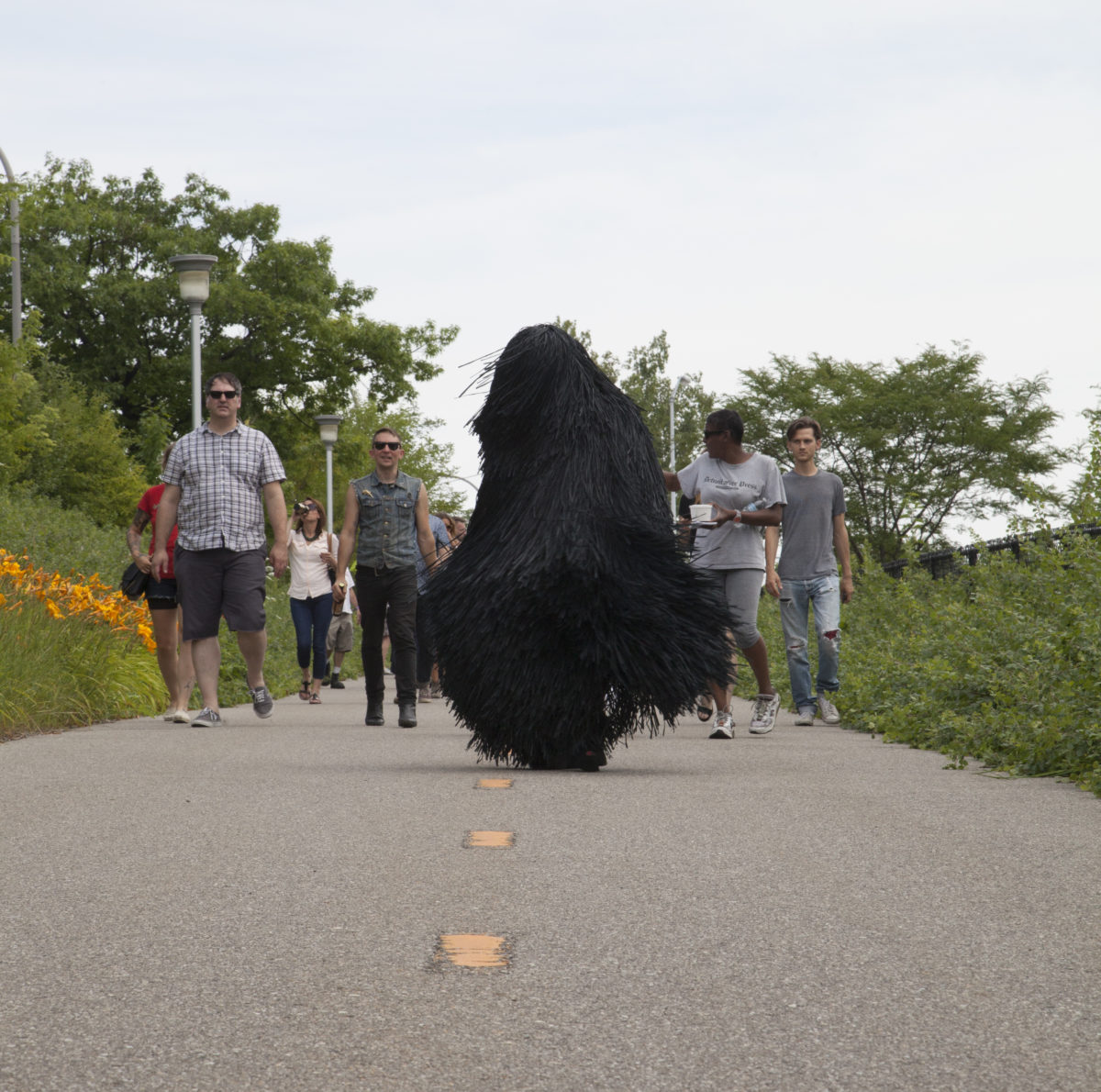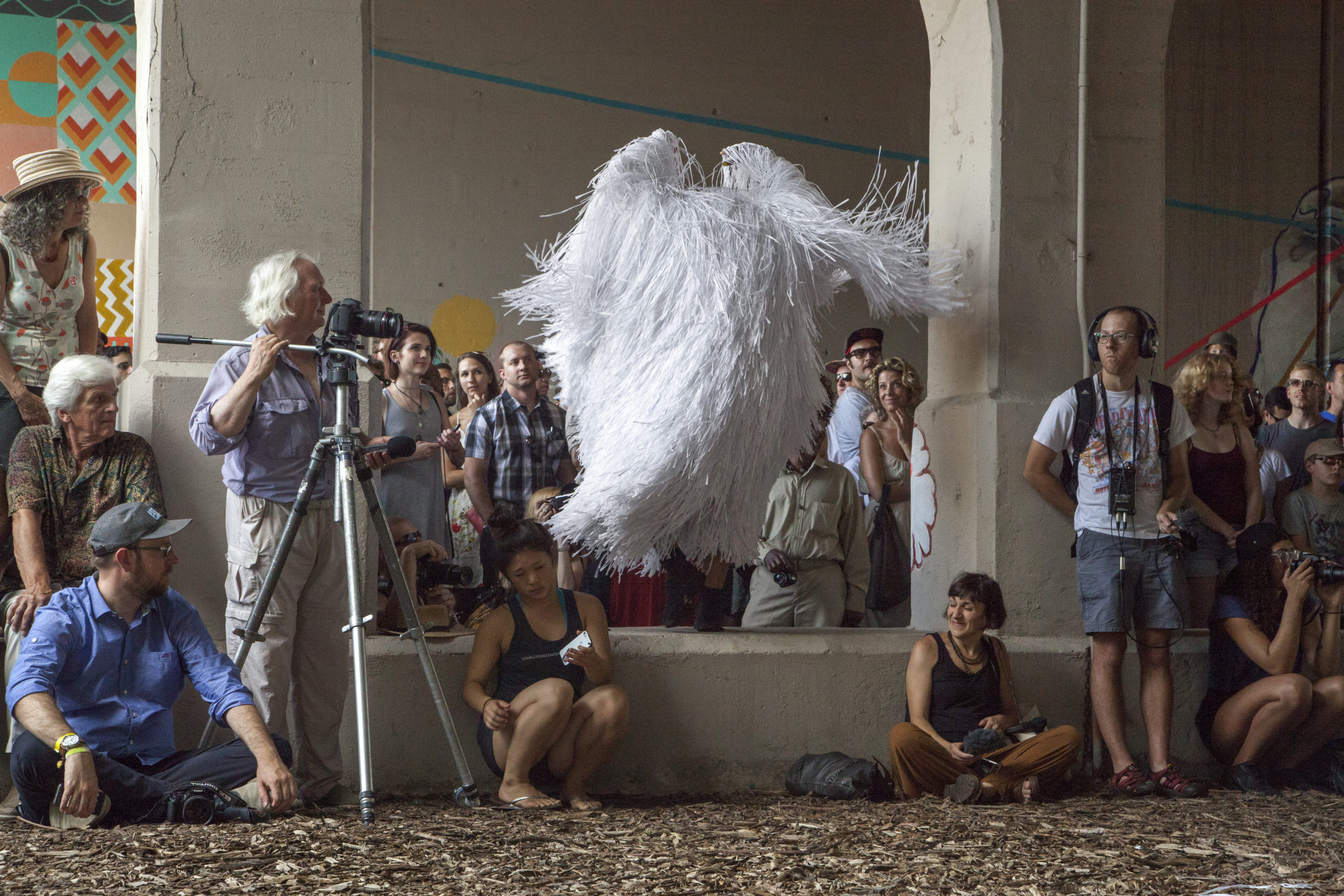Images courtesy of Cranbrook Art Museum.
Photography by PD Rearick.
Administrator: 9473, 2020
Bedsheets, throw blanket, printed flannel, treated canvas, Romex, wire, work shirt, rag, treated cotton, acrylic paint.
126” x 73” x 2”
It was a hot and humid afternoon in late July, 2015, on the Dequindre Cut, a recessed bike and walking path now paving what was once a rail line connecting the Detroit River and outlying areas, an important conduit connecting cycles of raw materials, their transformation, and export of finished product for the automobile and its accompanying industries. Grassy ribbons lined either side of the path. Overpasses painted with weathered, chipped graffiti and recently commissioned colorful street art murals offered partial shade on this sunny, vibrant day. Slowly people began to arrive for a 4.00 pm performance of a piece I’d choreographed in collaboration with nine other Detroit-based contemporary dancers. Working with composer Frank Pahl and his ensemble of post-Moondog influenced musicians, the performance was one of three “Dance Labs” initiated by Chicago based visual artist Nick Cave as part of his largest exhibition to date, Here Hear, curated by Laura Mott at the Cranbrook Art Museum, a small yet bucolic Saarinen designed art school and galleries in the wealthy suburb of Bloomfield Hills outlying Detroit. Cave had attended Cranbrook’s Art Academy, graduating in 1989, so this exhibition was a return to what he describes as an elemental period of his gestation as an artist, where Cranbrook had nurtured his “intellect,” and Detroit his “soul.”1Nick Cave, artist talk with students from Detroit School of the Arts and Wayne State University, Cranbrook Art Museum, Septemeber, 2015.
Central to Cave’s vision for the exhibition was the destabilization of his sculptural works’ architectural and disciplinary homes. Often exhibited as static objects, he sought to open up the pristine integrity of the white cube and spill his work out, down Woodward Ave, across Eight Mile, to infiltrate and highlight a diverse range of spaces in the City - spaces more and less visible in the more recent narratives chronicling more recent resurgence and (artistic) revitalization (Ruth Ellis Center, Campus Martius, Dequindre Cut, Riverfront, Brighmoor, etc.) His gesture is significant, as a means to enact an animated re-investment through and across the expanse of Detroit’s 142.9 square miles (370 kilometers), potentially effecting a softening of borders and the geographic segregation between city and suburbs which became increasingly calcified after the 1967 race rebellion. A city built for upwards near 2.5 million, it now holds fewer than 700,000 inhabitants. There are many factors at play in Detroit’s economic, social, and political conditions, but if we are to consider geography as a means by which to track capitalism’s movements, then Detroit’s “landed capital,” as David Harvey calls it, has largely been thought one of divestment and erosion. Cave’s Here Hear project enters into this landscape through a current of lively, contemporary, and well populated discussions attuning to the role of the artist, their labor and embodied facility, within the geospatial politics of the city.
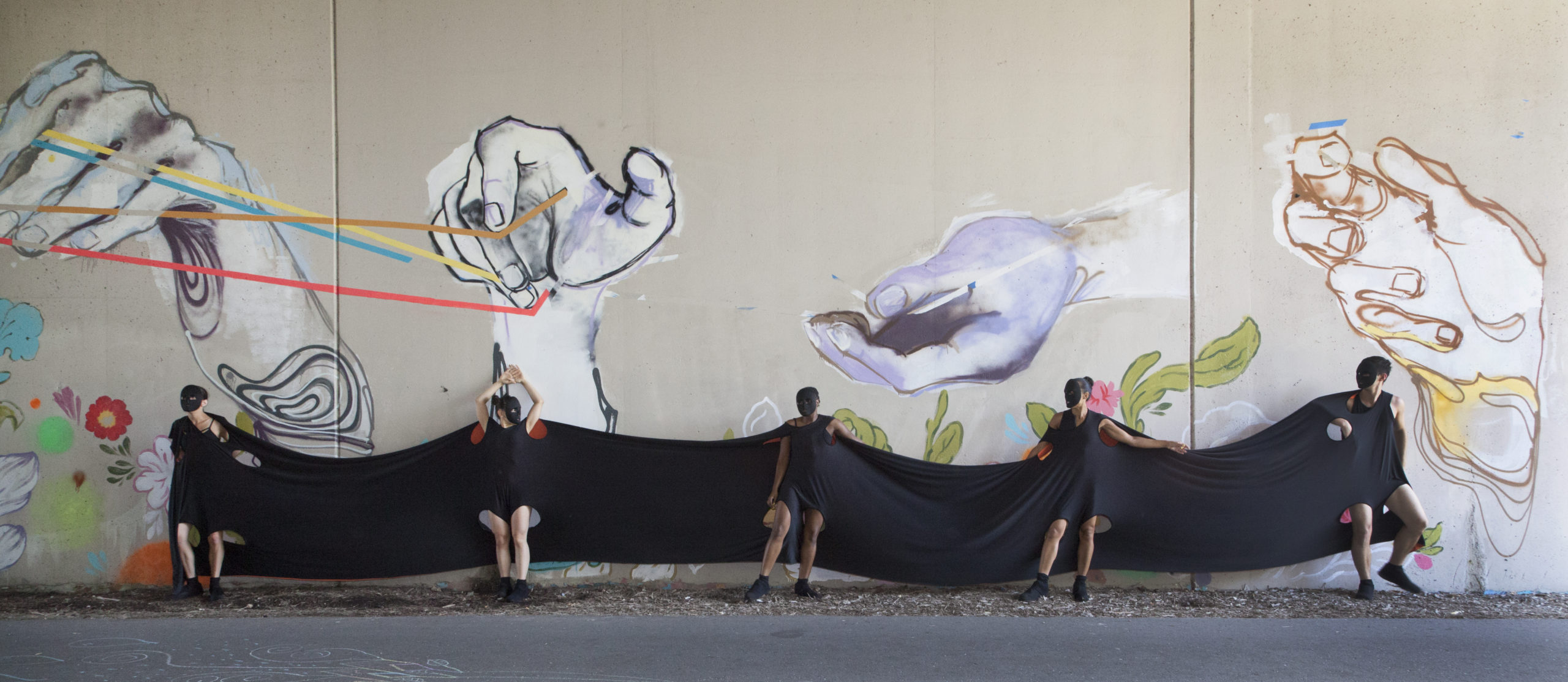
Administrator: 9147, 2020
Bedsheets, polar fleece, treated cotton, printed cotton, wood, poly fill, inkjet print, grommets, latex acrylic paint.
114” x 84” x 2”
Cave is best known for his soundsuits - ornate, intricate, colorful sculptural bodies, glittery, magical, extraordinary assemblages. Created in response to the 1992 Los Angeles riots, sparked by the beating of Rodney King, a significant incident of police brutality that provides a link between a historical past of racist terrorism and its endurance into the present. Responding to this moment, Cave created his first soundsuit, constructed out of wooden twigs found strewn across the ground, which he discusses as symbolic of the discarded. Thick clusters of deep brown sticks are woven together, hiding yet enlarging the body, a cocoon or an armor, animating and agitating. Once donned, the soundsuit suggests corporeal protection, adornment and ceremonial-like luster, and, when moved in, produces a stunning visual- and aural-vocality. Doubly obscuring and amplifying the body, spilling across disciplinary and aesthetic lines, soundsuits shake and shimmy in the milieu between performance, fashion, and sculptural object.
Cave’s prolific oeuvre consistently engages the realities of race, identity, and embodiment - he created a new soundsuit, TM 13, memorializing the death of Trayvon Martin for the Cranbrook exhibition - and as can be seen the objects that produce these sculptures not only are symbols of dispossession but function also as markers of memory, family, dreams, home. Layering and accumulating objects, the soundsuits begin to blend and blur meanings, signification. “Word’s don’t go there, word’s don’t go there,” a mantra culled from the aesthetics of the black avant-garde by the musical ear of Fred Moten. He writes, “signaling the excessive, out-from-the-outside motion and force with which sound infuses the verbal. Words don’t go there; words go past there. Bent. Turned. Blurrrred.” Gaining access to a potent territory rife with possibility, Cave’s textured, textile-rich soundsuits speak a particularly nuanced, relevant tongue in the context of Detroit, moving with a history of choreographic practices that detour the normalized flows that might generalize a 21st century “urban” fabric. The concept of fray becomes operative in Here Hear, offering means by which to redress contested spaces through a kind of unlocking and choreographic unraveling of its once tightly woven, circulatory grid.
Built by and for the automobile, emblematic of modernity’s corporeal flows - specifically of assembly line labor and its Taylorized accelerations - Detroit is known for its wide, streamlined boulevards. As industry moved elsewhere and populations continued to shrink, these once bustling throughways quieted and decelerated. Streetlights flickered and went dark, grass grew up over the sidewalks, homes vacated and neighbors moved out. A new landscape emerged, slowly, through the decades shifting focus from a swelling twentieth-century metropolis to what began to be referred to as a post-industrial cityscape, collapsing the birds-eye vantage integral to modernist urban design and planning, to realign, on the ground, with and at the scale of the body. At the turn of the twentieth- to twenty-first-century, Detroit did not reflect what Peter Sloterdijk discusses as modernity’s ontological “being-towards-movement” or its subsequent post-modern gridlock. This era of the city, often equated with divestment and vacancy, introduced another pedestrian dérive: the city-wide vernacular of walking down the middle of the street.2The human is never more or less than one. More and less than one, we’re walking down the middle of the street […] We are the engine that will …
If, like Michel de Certeau, we are to think of pedestrian pathways as narratives, enunciations expressed through the padding of footsteps, crunching concrete (shuffle, tap, shuffle, step), then there is a broad collection of stories today recording Detroit’s daily chronicles.3Michel de Certeau, in affinity with the Situationist dérive, relates the act of walking as type of script-bearing practice, inscribing space with … They starkly off-set other images conjured by the thought of an urban setting - the hyper-acceleration of bodies, collapse of space through the rush of time, streamlining Point A to Point B, eye on the clock, screen, traffic, crowds. I’ve talked with Detroiters through the years about this phenomenon and there are many explanations - avoidance of overgrown, uneven sidewalks, precarious vacant buildings, fallen branches, roofs, porches, avoidance of shadows that line an unlit street, a stranger obscured. This, and the considerable lack of cars (and thus capital) occupying the well-established wheel-and-spoke topography that connects the extensive footprint of the Motor City. This street-side ambulatory figure is mobilized by an excess of meaning - choreopolitical, to cite André Lepecki’s term, a dancing as a co-constitutive strategy of “Taking place. Being taken by place.”4André Lepecki, “topo-archi-choreographic (or: the politics of placing), in Le Mouvement: Choreographing the City, (Berlin: DISTANZ Verlag, 2014), … Lepecki, closely employing Jacques Rancière’s definitions of the political and policing, writes that choreopolitics enables a subject to emerge, to be seen, an agent of address. This specifically qualified political subject appears “away from preassigned modes and spaces of circulation, as the political subject. Its appearance results from its excessiveness and unforeseen mode of reclaiming spaces for mobility,” and transforming “spaces of circulation into spaces of freedom.”5André Lepecki, “Choreopolice and Choreopolitics: or, the task of the dancer,” in TDR: The Drama Review 57. 4 (Winter 2013): 20. Loitering, he discusses as a threat, choreopolicing as a performative call to move along. How does loitering function against the grain of labor and leisure? It is through these transformative acts that the dancer, then, becomes visible. I find the radical engagement with space, and place - specifically its architectural, material, and social structures - one of the most exciting aspects of dance’s contemporaneity. What it does through the lens of where it lands and, furthermore, how dance makes visible the potential of the where that lands it. Caught in the wake of Detroit’s post-industrial cityscape, the boulevard becomes horizon for a re-entry of Jane Jacob’s sidewalk dancer through a stepping out onto the stage set by the automotive culture that sparked Detroit’s boon. A topographic scene produced as an effect of its economic, geo-capital fray, this dancer acts as a connective agent whose walk might produce many meanings, oversaturated. It de-territorializes past mobilities. It reflects contemporary conditions of precarity. And, it inscribes an “open score” for future choreographic flows.
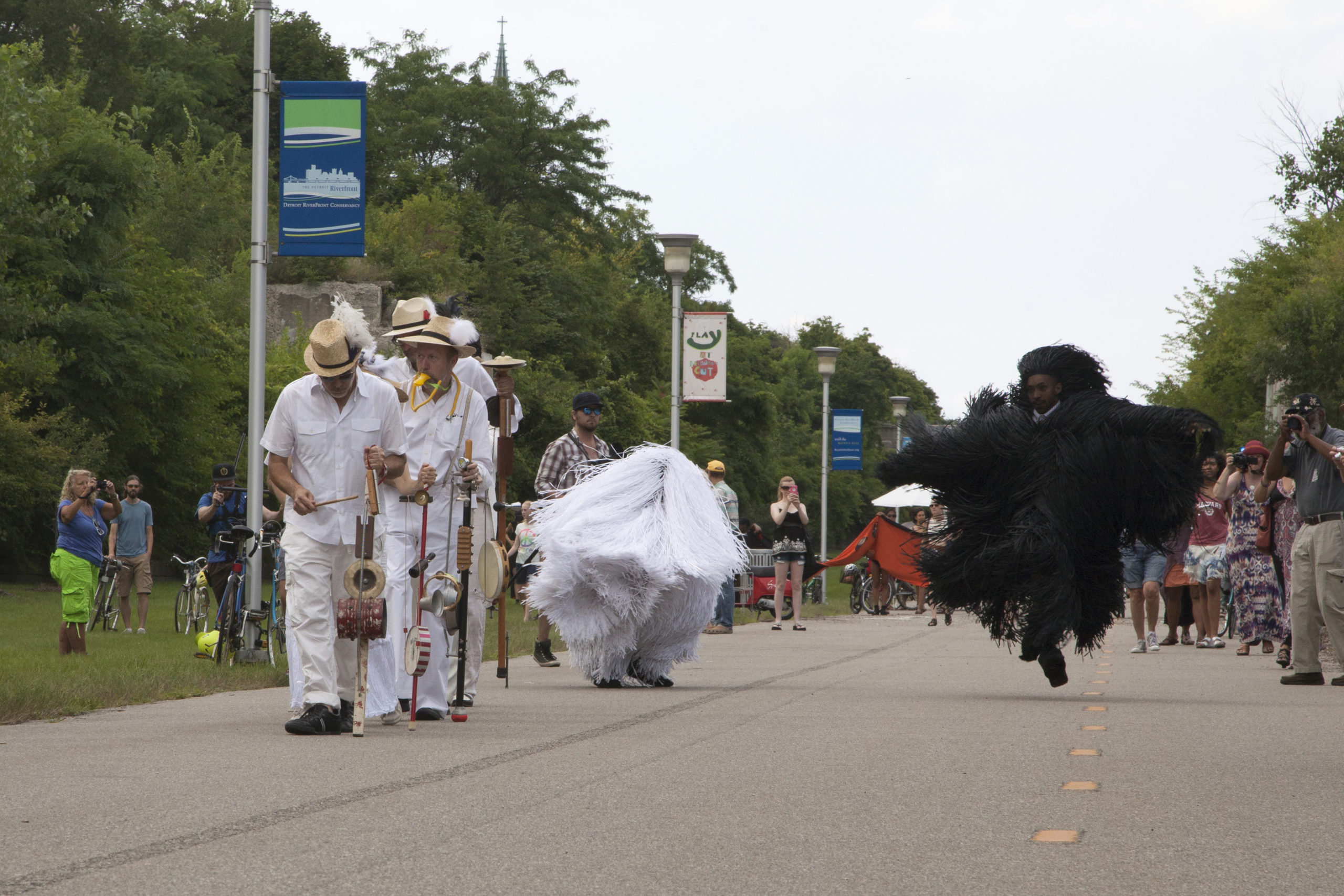
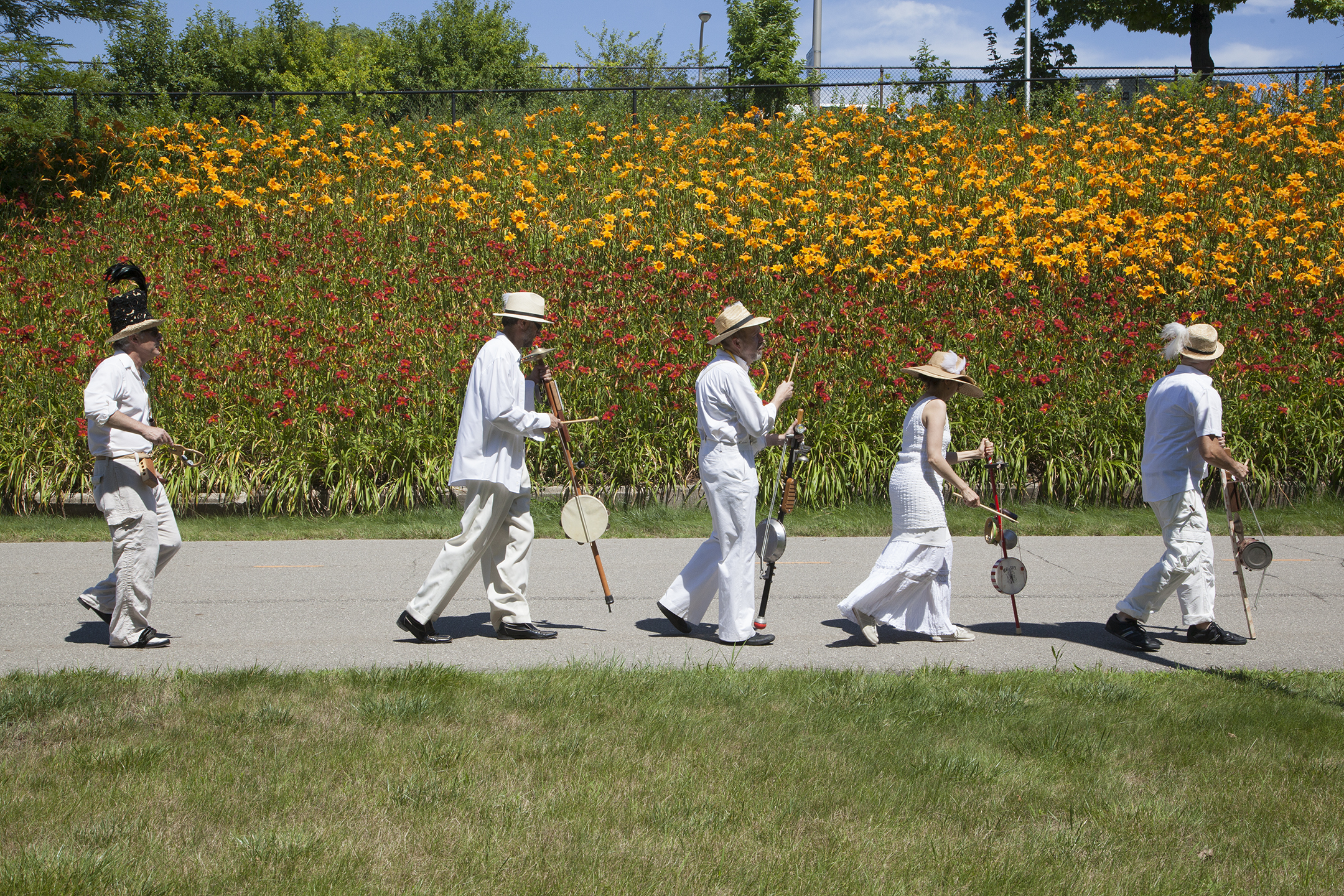
Exploring materiality anchors my practice in the familiarity of my personal experience. I understand process itself is a material, and as materials are entangled with the larger social ecology, my process and practice are also entangled with the larger social ecology. Any material or object is rich with historical experience no matter whose body chooses to embody the working properties of that material. Rope, for example, has been made and used by cultures the world over for centuries and for many reasons. The consumption and meaning of rope are not only dependent on how it is used, but also who uses it and for what. This is the complex process and entanglement of material and body, and within this complexity simple individualization, a kind of appropriation of uniqueness, cannot occur. The body that chooses to practice with material will examine the material in process, and in turn, will develop an orchestra of information out of the entanglement of material and body. With this in mind, I prefer to see a painting as a document.
In my own conception of art, the notion of a painting, and the notion of the self, and the notion of the self making a painting exceeds the popular image of art as self-expression. Perhaps, if I even tried to create an expression, that expression would in fact be inadequate bordering on false due to the inherent complexities of my entanglement within the larger social ecology. Cause and effect cannot begin with an idea, and end with a painting. The idea, and the painting, are not empirically important for my practice. Perhaps what is most important is action and effect. Primary action is seemingly stimulated from the momentum of previous actions, those of which can go back as far as one cares to examine. The effect is maybe not a sum but another action as well. Though the effect can perhaps germinate knowledge that moves forward, a kind of ripple. Not forward as in linear, but, perhaps outward, in all directions.
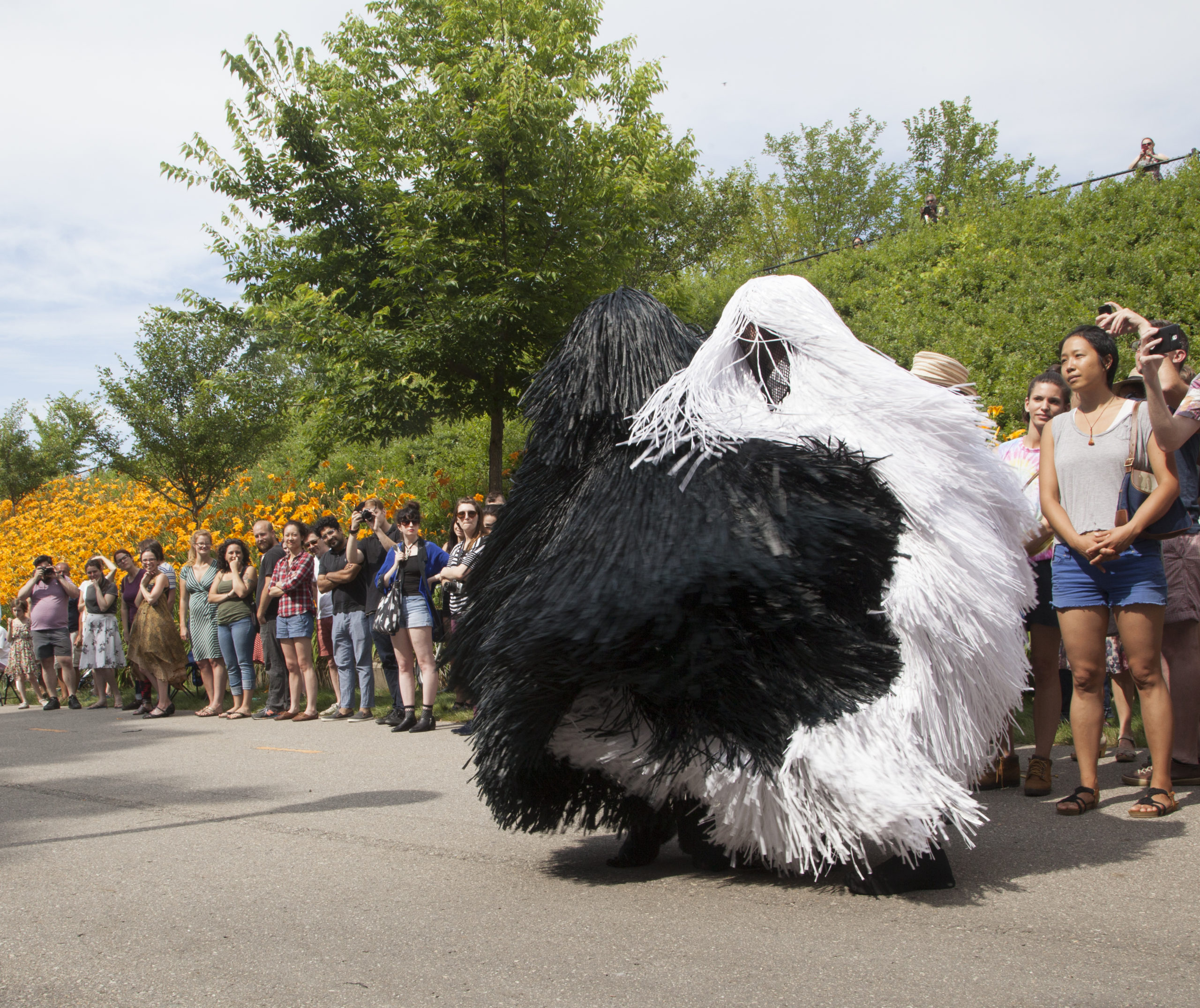
This street scène6A scène, theorized by Frédéric Pouillaude as a temporal simultaneity indicative of the contemporary, the site of the choreographic as it is … marks the intersection of multiple spaces - the striated space “par excellence” and a smooth, holey, “scrap metal and fabric,”7See Detroit artist Scott Hocking’s considerable contribution to the economic, political, and cultural implications of the highly contested yet … to employ Gilles Deleuze and Félix Guattari’s terminology.8Gilles Deleuze and Félix Guattari, A Thousand Plateaus: Capitalism and Schizophrenia (Minneapolis: University of Minnesota Press, 1987), 480. Rough, potholed, uneven are these streets, open yet akimbo. Jessica Ray, a choreographer and friend who visited Detroit from New York, sent me a picture from Hamtramck Drive, the home of Chrysler’s Dodge Main Plant from 1910-1981 and now rebuilt as GM’s Detroit / Hamtramck Plant. This was also on the route of my daily commute between home and the University where I teach. She wrote: “I was inspired to take a picture after zigzagging across an empty 5 lane street.” Additionally, a local Detroiter, Putnam Weekly, began an Instagram hashtag #fromleftlane, chronicling the occurrence of vantages set throughout the city, of the city, from the left lane.
Zigzagging across the city, an alternate mapping of trajectories through and across the city’s grid, Detroit’s ambulatory practices belie a differentiation of flow, rhythm, and circulation throughout the city, that extends both on and off road, Sara Ahmed, asks us to consider the “official” paths marking out disciplinary homes, which shape space and time through the force of inheritance.9Sara Ahmed, Queer Phenomenology: Orientations, Objects, Others (Durham: Duke University Press, 2006), 22. Deviating from these lines are paths of desire, tracing the unexpected yet everyday actions of coming and going.10Ahmed, Queer Phenomenology, 20. Unraveling prescribed routes, embellishing what Lepecki claims is “an impoverished choreographic imagination,” the street becomes a metaphorical seam wherein the striated and smooth intersect. In the context of Hear Here, the dancer performed agent and liaison amongst this topographic fray, and Cave’s soundsuits were invited into Detroit’s scene of spatial possibility.
Hear Here’s Dance Labs involved two choreographers besides myself: Marcus White, who choreographs within the vernaculars of contemporary postmodern techniques and what he discusses as “black queer movement performance” (mainly waacking and voguing).11Marcus White’s unexpected passing in 2020, since the writing of this paper, has had a profound impact on the dance and performance community in … White worked in collaboration with techno legend and co-founder of Underground Resistance Mike Banks. And Haleem ‘Stringz’ Rasul, an ambassador of Jit (a dance style that comes out of the Jitterbug tradition and holds Detroit’s card in the “footworks” music/dance scene), who collaborated with UDO Afrobeat Orchestra. With a limitation of 3-5 days to create a performance with their musical collaborators, each Dance Lab began with the ritual of opening a large cardboard box while white gloved handlers unveiled the set of materials selected by Cave for the respective choreographic ensemble.
It is no easy task to dance in one of Cave’s soudsuits. They are extraordinarily varied. They are meticulously crafted and with dizzying opulence. Buttons, beads, silk, wire, felt, string, plastics, they are wiry, flowery, glittery, soft, porous, pneumatic, voluminous. Their textures propose an unexpected range of embodied states, physicalized tones, energetic fields and pathways. Investing in Eve Sedgewick’s poetic, which considered understanding in the personal, haptic forces of such vibrant material: “to touch is always already to reach out, to fondle, to heft, to tap, or to enfold, and always also to understand other people or natural forces as having effectually done so before oneself, if only in the making of the textured object.”12Eve Sedgwick, Touching Feeling (Durham: Duke University Press, 2002), 13-14. A choreographic score is sewn along the seams of the suit - a train-like extension along the front of the body might inspire flow along the sagittal plane, asymmetrical contours shifts between contra- and homo-lateral phrasing, spirals, or undulations - informing the transformative potential his work actively embraces.13I’m reminded of Fred Moten’s assessment of spatial politics inherited from the historical legacy of the black avant-garde - constraint, mobility, … Cave also finds inspiration from the ceremonial fatigues of African traditions, and the suits, once adorned, signify transformation resonant in the external world - from found objects of the everyday into celebratory, unruly, enigmatic figures - and the internal world - the body sweats, breaths, pants, encounters unknown centers of gravity, speeds and slowness. For the dancer, a sometimes bewildering process. Many of the suits dancing in the Dance Labs were made of raffia strips, similar to giant pompoms, whose varying shapes and colors created a spectrum of moods, sway, and ambulatory adjustments.
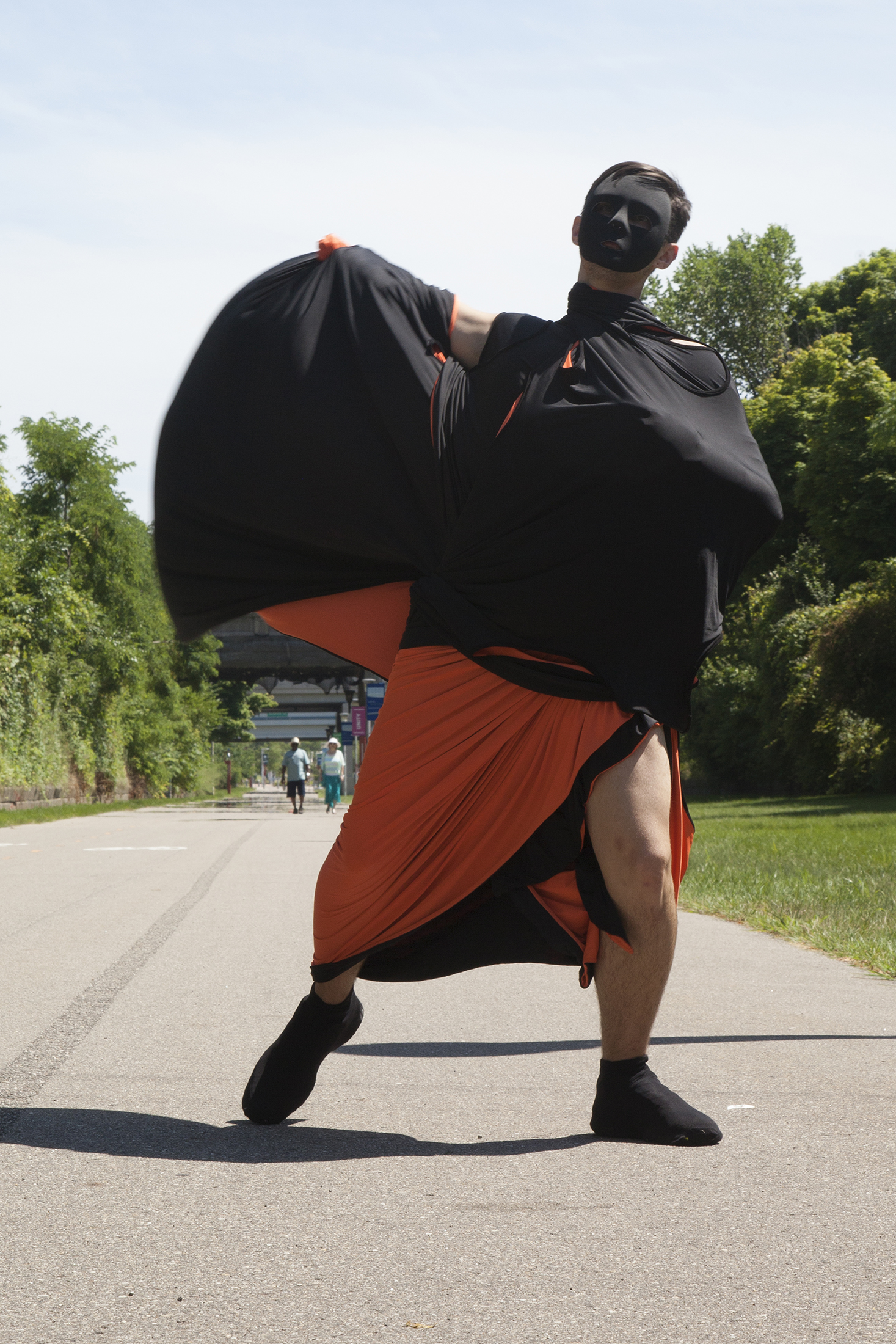
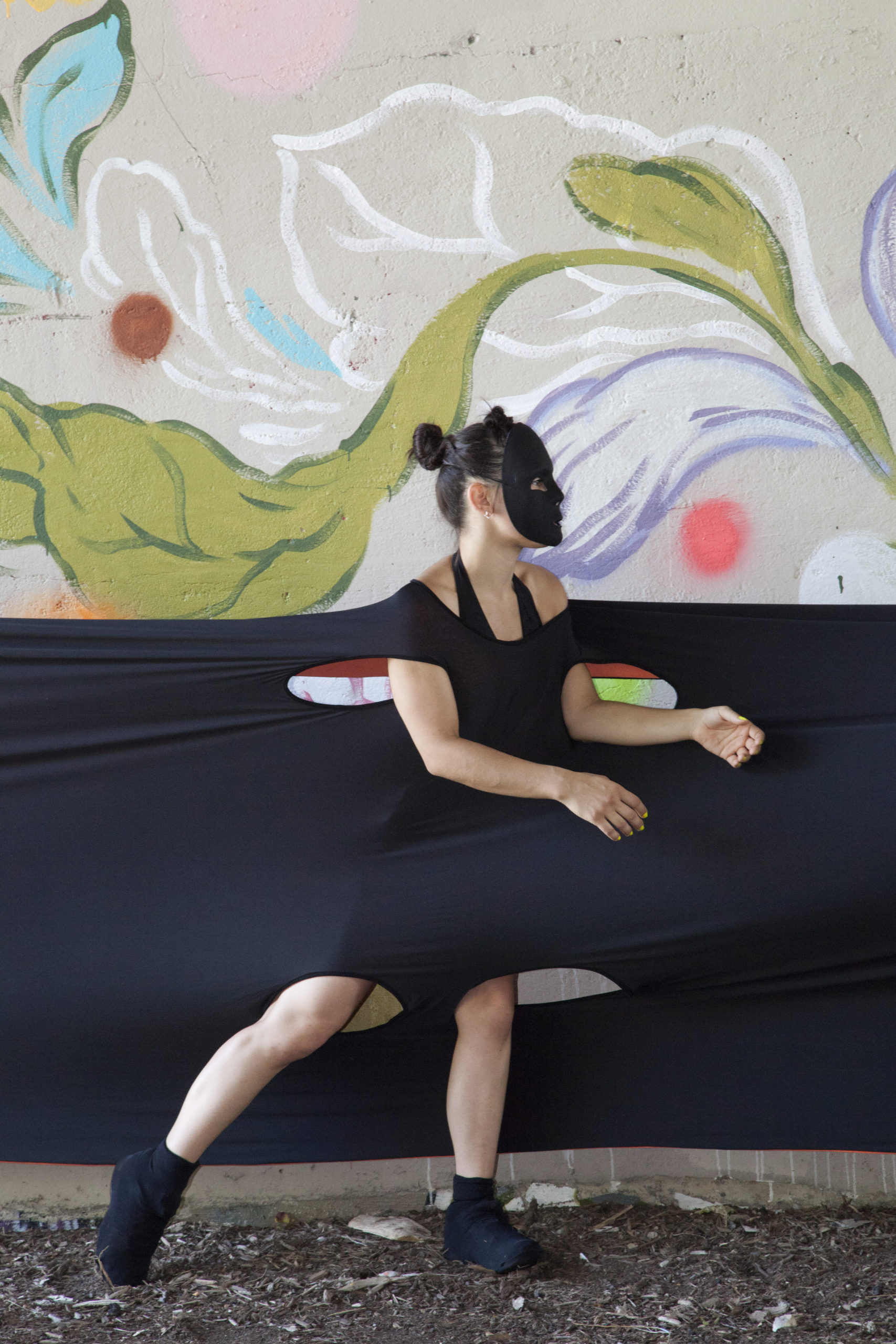
“Ebony and ivory live together in perfect harmony
Side by side on my piano keyboard, oh Lord, why don’t we?”
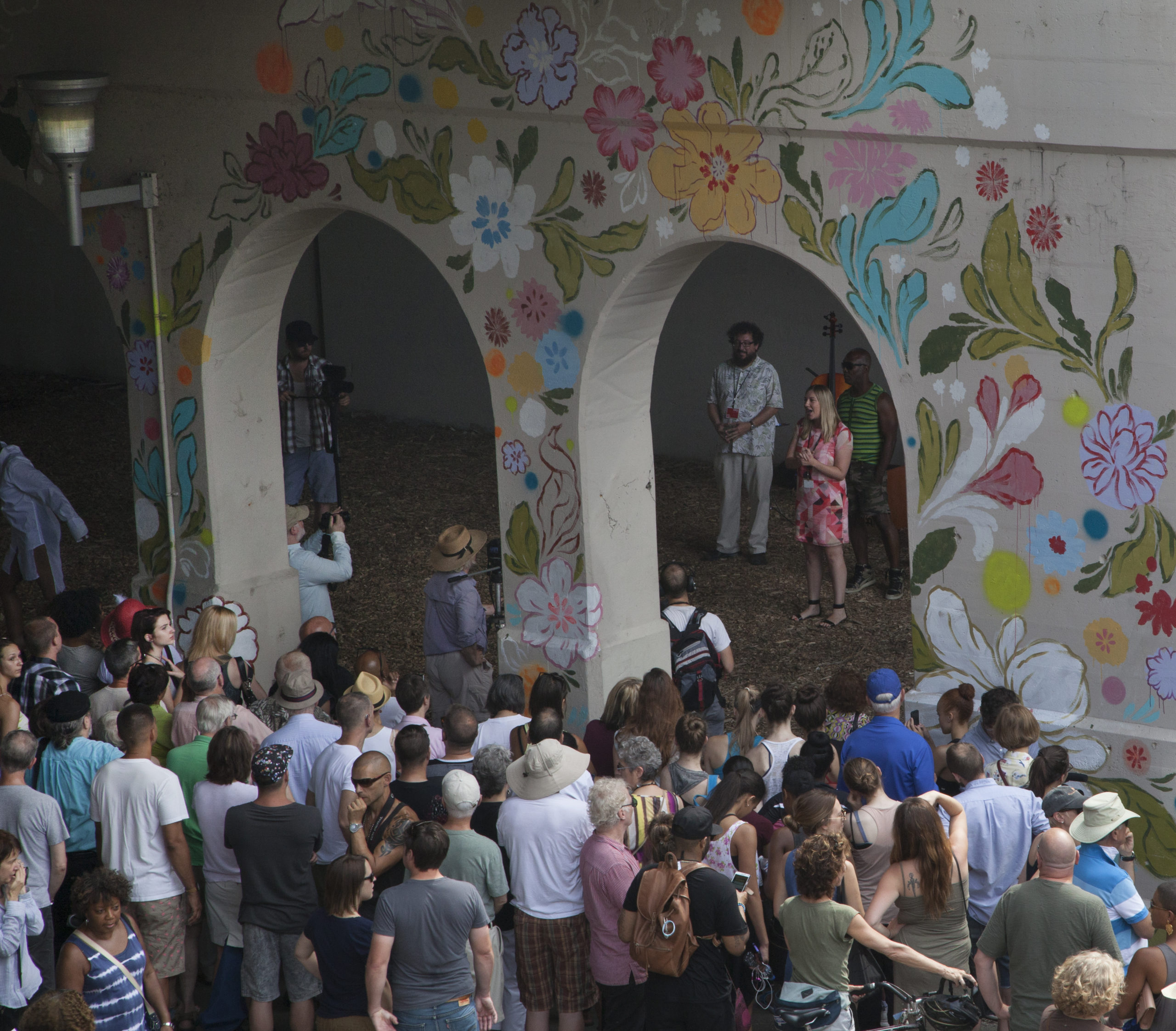
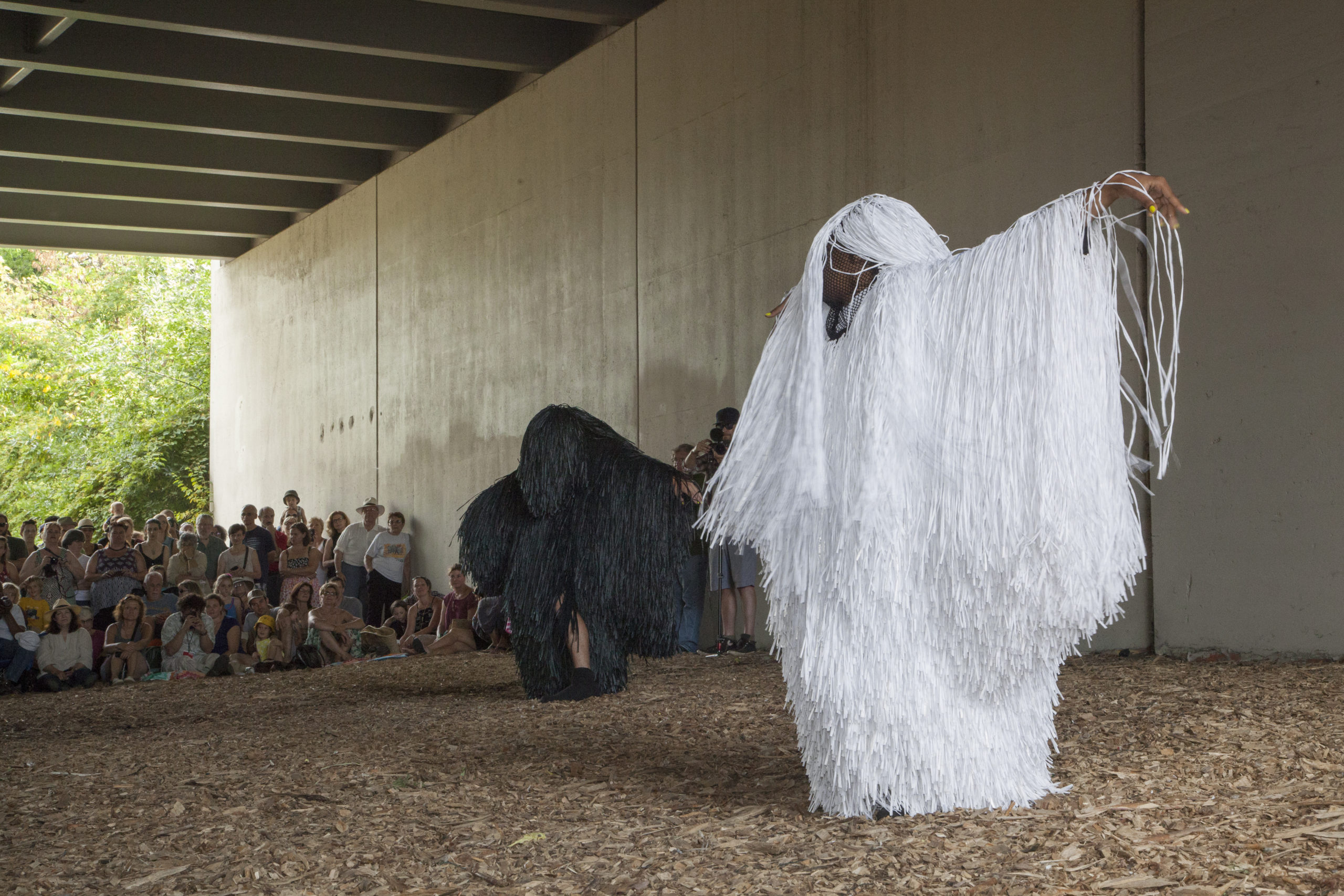
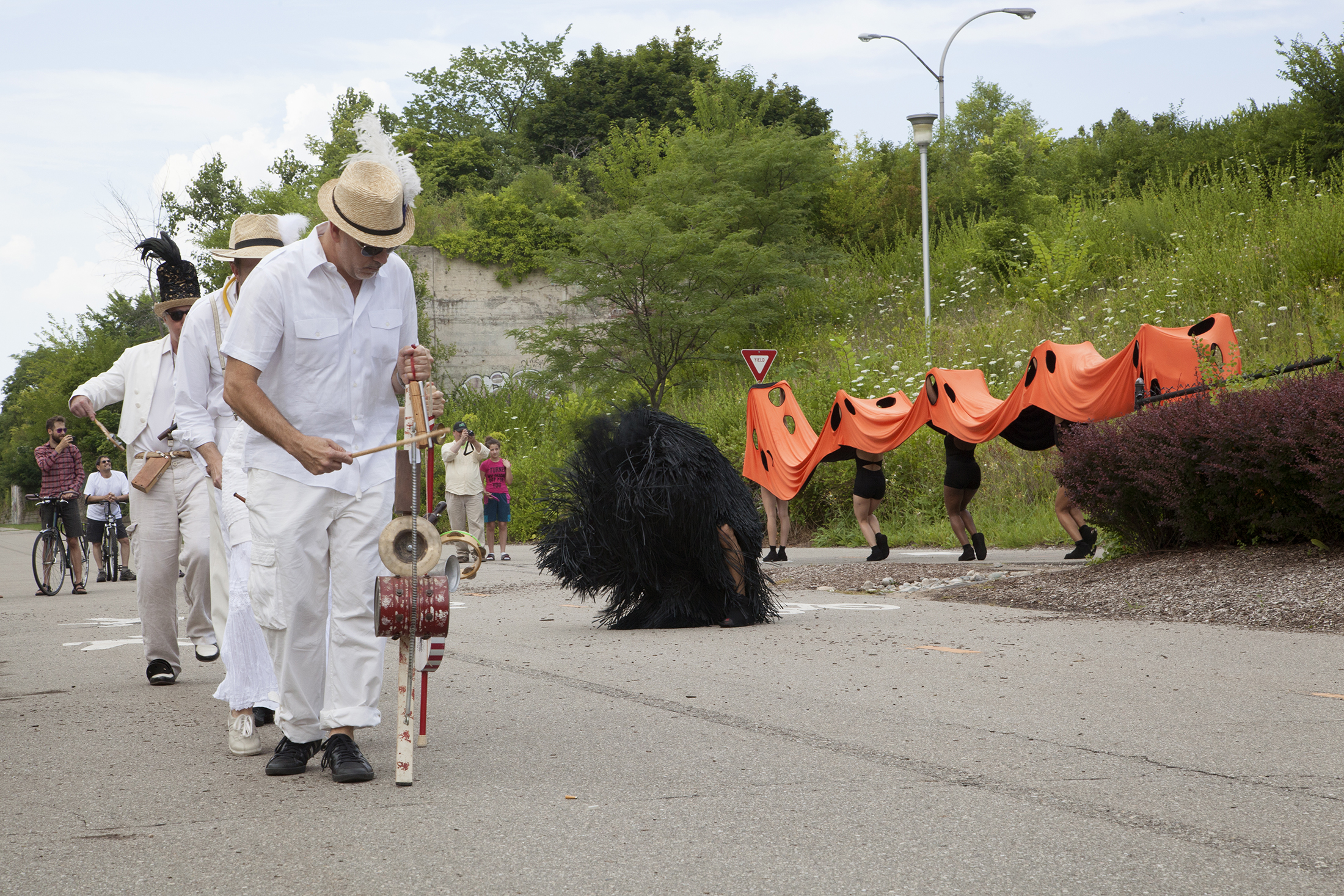
Dancers: Rachael Harbeart, Jordan Holland, Samuel Horning, Ta’Rajee Omar, Andrew Sanger, Maya Stovall, Erika “Red” Stowall, Christopoher Woolfolk
Music: Frank Pahl with The Lovely and the Wretched
Costumes: Randall Jacobs
References
